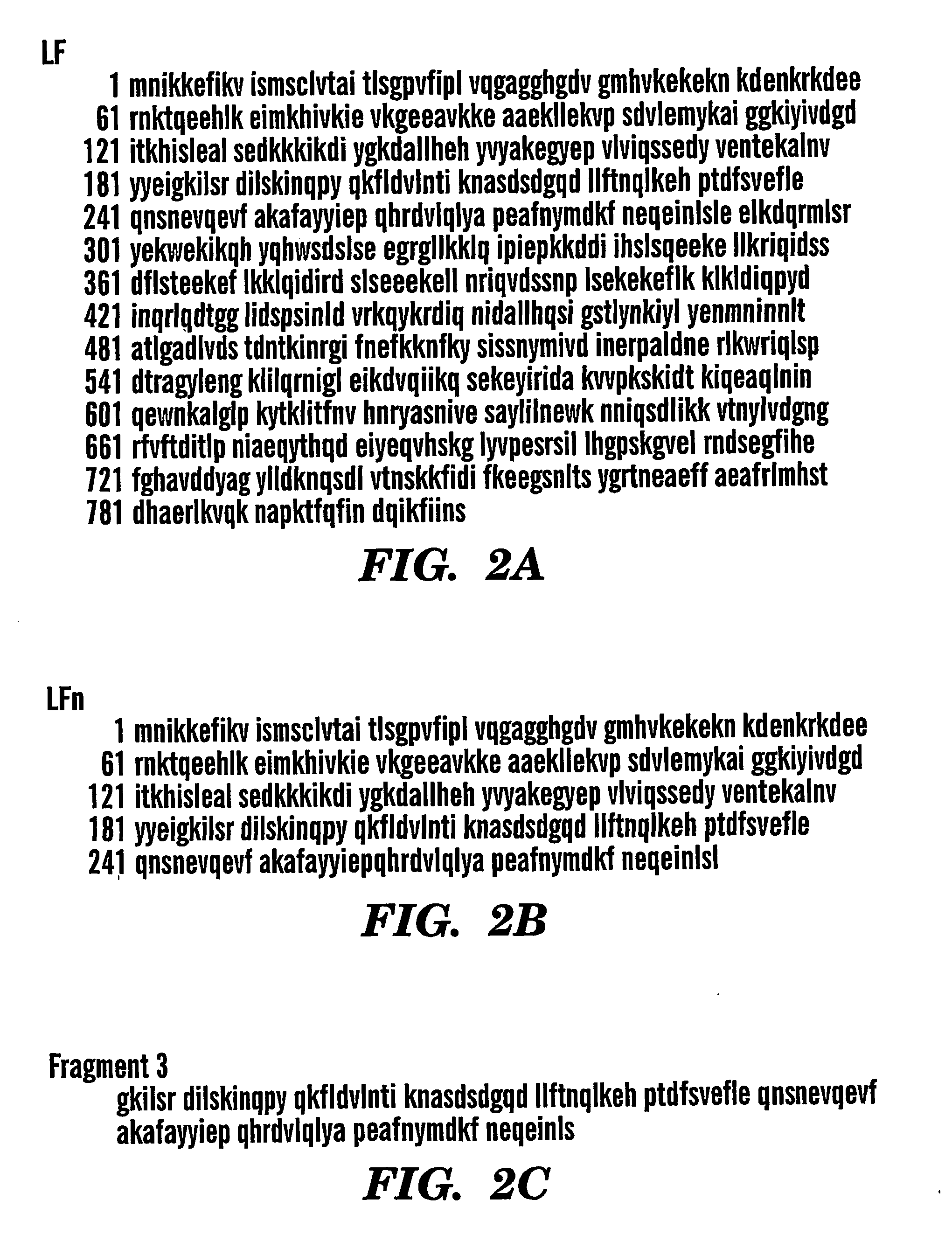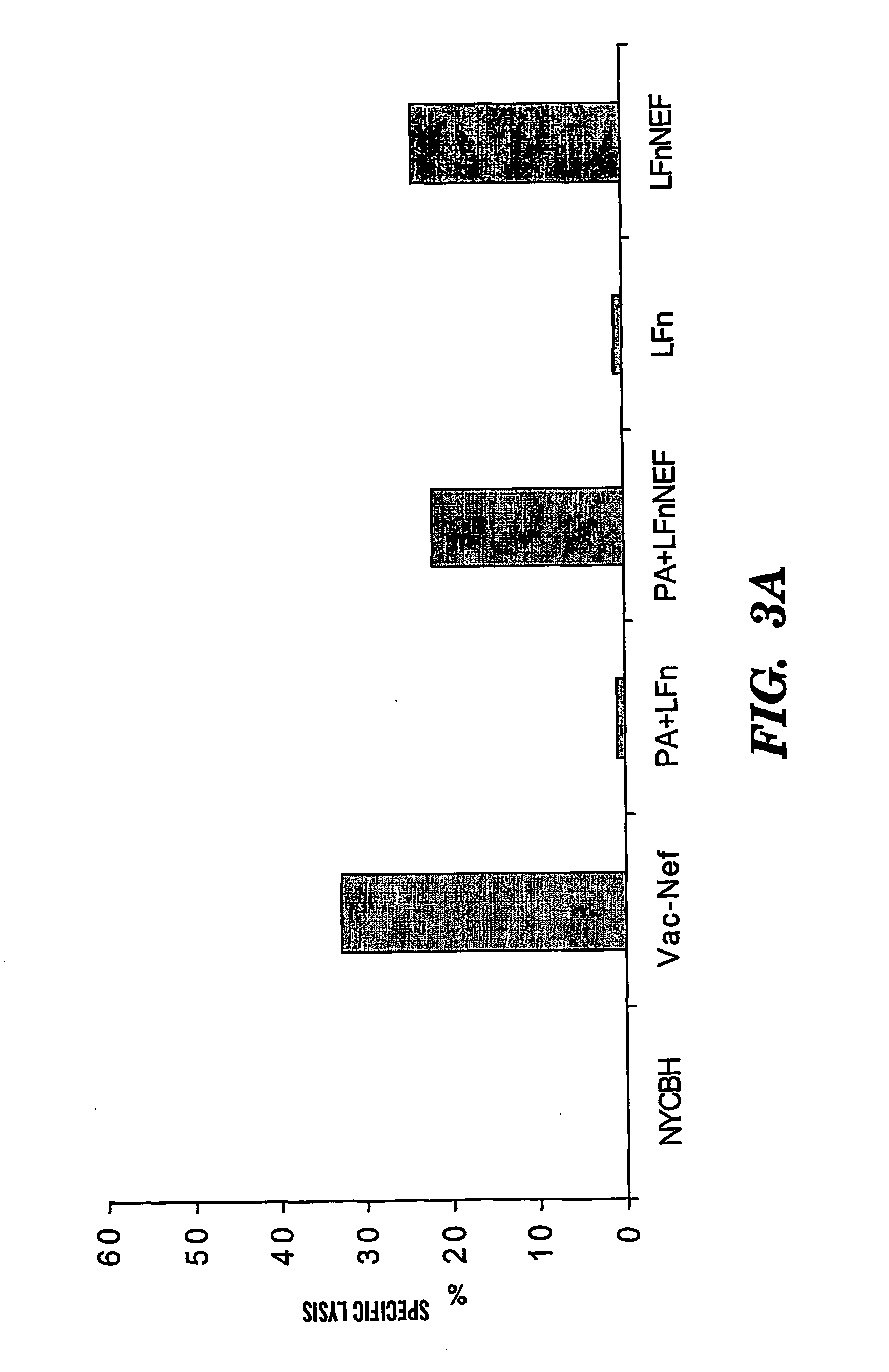Methods of delivery of exogenous proteins to the cytosol and uses thereof
a technology of exogenous proteins and cytoplasm, which is applied in the direction of fusion polypeptides, macromolecule non-active ingredients, viruses, etc., can solve the problems of many drawbacks, and insufficient antibody response to virus and portions thereo
- Summary
- Abstract
- Description
- Claims
- Application Information
AI Technical Summary
Benefits of technology
Problems solved by technology
Method used
Image
Examples
example 1
Materials and Methods
LFn-HIV Fusion Proteins
[0100] The DNA fragment encoding env gp120, gag p24 from HIV-HXB were amplified by PCR, cloned into the LFn expression plasmid pET15bLFn, and sequenced to verify the inframe fusion between the LFn and the HIV coding sequence. The Nef coding sequence was amplified from HIV-ELI. The protein expression vector for LFn and its fusion derivatives is the pET15b plasmid (Novagen; Madison, Wis.). The main features of this vector system include an inducible T7 promoter, an internal His-Tag for protein purification, and multiple cloning sites. The recombinant LFn is expressed in E. coli as an intracellular soluble protein with 6 tandem histidine residues at its N-terminal end (14). Bacteria were grown in a ten-liter Bioflow 2000 bench top bioreactor (New Brunswick Scientific, NJ). Purification of the His-tagged proteins was conducted using a commercial kit according to the manufacturer's protocol (Novagen). Fragments of LFn can be made by modifyi...
example 2
[0116] LFn fusion proteins in the absence of PA are also capable of sensitizing CTL target cells in a MHC-I restricted manner. This cytosolic delivery of LFn fusion proteins relies on functional transportation associated with intracellular antigen processing inside an antigen-presenting cell (Cao H, Agrawal D, Kushner N, Touzjian N, Essex M, and Lu Y. J. Infect. Dis. 185:244-251 (2002)). We have now demonstrated that Green Florescence Protein (GFP) fused with LFn can enter into cells in the absence of PA. We further show that this PA-independent LFn delivery of exogenous GFP appears to be associated with cellular proteosome, which is consistent with the previous observation.
Construction and Purification of LFn-GFP and GFP
[0117] LFn-GFP fusion protein was constructed by insertion of the GFP open reading frame from pEGFP-C1 (Clontech) into the LFn expression vector described in previous studies (Lu, Y., R. et al., Proc. Natl. Acad. Sci. USA 97:8027-32 (2000)). The fusion protein is...
example 3
Deletion of the N-Terminal Half of LFn, and the Adjuvant Effect of Alum on LFn Immunization
[0121] Additional animal immunization data demonstrates that the N-terminal half of LFn, which contains the PA binding domain, can be deleted with no negative effect on the antigen delivery. Quite unexpectedly, we found that the addition of Alum could significantly enhance the CTL induction by the LFn fusion proteins.
[0122] Despite many unsuccessful attempts in the past two years, we have been unable to show that LFn-p24 in the presence of PA could stimulate CTL in immunized BALB / c mice. Previous studies have shown that LFn fusion proteins such as LFn-V3, LFn-LLO, and LFn-OVA are capable of stimulating specific CTL in mice (Lu, Y., et al. Proc. Natl. Acad. Sci. USA 97:8027-32 (2000); Ballard, J. D. et al., Proc. Natl. Acad. Sci. USA 93, 12531-12534 (1996); Ballard, J. D., et al., Infect. Immun. 66, 615-619 (1998)). These fusion proteins carry only 12 to 33 amino acids, whereas LFn-p24 carri...
PUM
| Property | Measurement | Unit |
|---|---|---|
| Fraction | aaaaa | aaaaa |
| Transport properties | aaaaa | aaaaa |
| Immunogenicity | aaaaa | aaaaa |
Abstract
Description
Claims
Application Information
 Login to View More
Login to View More - R&D
- Intellectual Property
- Life Sciences
- Materials
- Tech Scout
- Unparalleled Data Quality
- Higher Quality Content
- 60% Fewer Hallucinations
Browse by: Latest US Patents, China's latest patents, Technical Efficacy Thesaurus, Application Domain, Technology Topic, Popular Technical Reports.
© 2025 PatSnap. All rights reserved.Legal|Privacy policy|Modern Slavery Act Transparency Statement|Sitemap|About US| Contact US: help@patsnap.com



